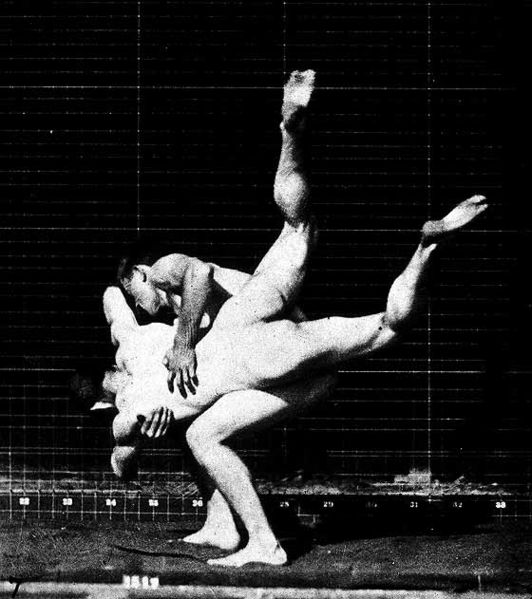On this day, a hundred and one years, ago the pioneering photographer Edweard Muybridge died, at the age of seventy four. This week’s picture is a photographic plate entitled Two Men Wrestling, from his eleven-volume work Animal Locomotion. Published in 1887, Muybridge’s magnum opus was an electrophotographic investigation of consecutive phases of animal movement, comprising more than two thousand individual pictures of men, women and animals – “all actively engaged,” in the photographer’s own words, “in walking, galloping, flying, working, playing fighting, dancing, or other actions incidental to everyday life, which illustrate motion and the play of muscles.”
Muybridge was a colourful and volatile character. He was born Edward James Muggeridge, in 1830, at Kingston upon Thames, in Surrey, the son of a corn chandler named John Muggeridge and his wife Susannah. In 1851 he changed his name and emigrated to New York, where he made friends with a daguerrotypist named Silas T. Selleck, who introduced him to photography. Having made a name for himself as a landscape photographer working in the mid-West, Muybridge came to the attention of the Governor of California, Leland Stanford, a great afficionado of racing, who employed him to solve the riddle of whether all four legs of a galloping horse were ever off the ground at the same time. Muybridge used several cameras, lined up beside a race-track at regular intervals, to record the motions of Leland Stanford’s prize trotter, “Occident”. These experiments were interrupted when Muybridge’s wife, Flora Shallcross Stone, a young woman half his age, gave birth to a son whom the photographer believed to have been fathered by the English drama critic and adventurer Harry Larkyns. Muybridge shot his rival dead in a fury. Although he was acquitted at the subsequent trial he judged it politic...


